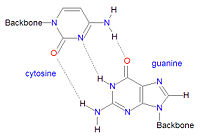Guanine: Difference between revisions
Jump to navigation
Jump to search

imported>David E. Volk No edit summary |
imported>David E. Volk No edit summary |
||
| Line 17: | Line 17: | ||
'''Guanine''' is a natural biomolecule used as one of the five bases in RNA and DNA. It is incorporated into these nucleic acids in the form of [[guanosine]], a chemical compound formed by the combination of guanine and a ribose sugar. Guanine is also naturally present in phosphorylated forms of [[guanosine]]. | '''Guanine''' is a natural biomolecule used as one of the five bases in RNA and DNA. It is incorporated into these nucleic acids in the form of [[guanosine]], a chemical compound formed by the combination of guanine and a ribose sugar. Guanine is also naturally present in phosphorylated forms of [[guanosine]]. | ||
== Basepairs == | |||
[[Image:Guanosine-cytodine basepair.jpg|left|thumb|200px|{{#ifexist:Template:Guanosine-cytodine basepair.jpg/credit|{{Guanosine-cytodine basepair.jpg/credit}}<br/>|}}Add image caption here.]] | |||
Guanine and [[cytosine]] form a very stable base pair containing three hydrogen bonds. | |||
Revision as of 13:56, 8 April 2008
|
| |||||||
| guanine | |||||||
| |||||||
| Uses: | |||||||
| Properties: | DNA/RNA base | ||||||
| Hazards: | |||||||
| |||||||
Guanine is a natural biomolecule used as one of the five bases in RNA and DNA. It is incorporated into these nucleic acids in the form of guanosine, a chemical compound formed by the combination of guanine and a ribose sugar. Guanine is also naturally present in phosphorylated forms of guanosine.
Basepairs
Guanine and cytosine form a very stable base pair containing three hydrogen bonds.

